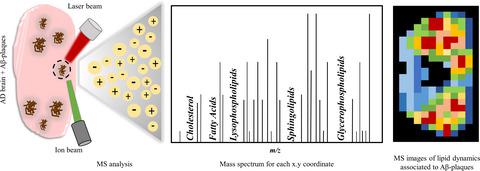当前位置:
X-MOL 学术
›
J. Neurochem.
›
论文详情
Our official English website, www.x-mol.net, welcomes your
feedback! (Note: you will need to create a separate account there.)
Spatially resolved mass spectrometry analysis of amyloid plaque-associated lipids
Journal of Neurochemistry ( IF 4.2 ) Pub Date : 2020-10-13 , DOI: 10.1111/jnc.15216 Martina Blank 1, 2 , Carsten Hopf 1
Journal of Neurochemistry ( IF 4.2 ) Pub Date : 2020-10-13 , DOI: 10.1111/jnc.15216 Martina Blank 1, 2 , Carsten Hopf 1
Affiliation

|
Over the last 10 years, considerable technical advances in mass spectrometry (MS)-based bioanalysis have enabled the investigation of lipid signatures in neuropathological structures. In Alzheimer´s Disease (AD) research, it is now well accepted that lipid dysregulation plays a key role in AD pathogenesis and progression. This review summarizes current MS-based strategies, notably MALDI and ToF-SIMS imaging as well as laser capture microdissection combined with LC-ESI-MS. It also presents recent advances to assess lipid alterations associated with Amyloid-β plaques, one of the hallmarks of AD. Collectively, these methodologies offer new opportunities for the study of lipids, thus pushing forward our understanding of their role in such a complex and still untreatable disease as AD.
中文翻译:

淀粉样斑块相关脂质的空间分辨质谱分析
在过去的 10 年中,基于质谱 (MS) 的生物分析技术取得了相当大的进步,使得对神经病理结构中脂质特征的研究成为可能。在阿尔茨海默病 (AD) 研究中,现在人们普遍认为脂质失调在 AD 的发病机制和进展中起着关键作用。本综述总结了当前基于 MS 的策略,特别是 MALDI 和 ToF-SIMS 成像以及结合 LC-ESI-MS 的激光捕获显微切割。它还介绍了评估与淀粉样蛋白 β 斑块相关的脂质改变的最新进展,这是 AD 的标志之一。总的来说,这些方法为脂质研究提供了新的机会,从而推动了我们对它们在像 AD 这样复杂且仍然无法治愈的疾病中的作用的理解。
更新日期:2020-10-13
中文翻译:

淀粉样斑块相关脂质的空间分辨质谱分析
在过去的 10 年中,基于质谱 (MS) 的生物分析技术取得了相当大的进步,使得对神经病理结构中脂质特征的研究成为可能。在阿尔茨海默病 (AD) 研究中,现在人们普遍认为脂质失调在 AD 的发病机制和进展中起着关键作用。本综述总结了当前基于 MS 的策略,特别是 MALDI 和 ToF-SIMS 成像以及结合 LC-ESI-MS 的激光捕获显微切割。它还介绍了评估与淀粉样蛋白 β 斑块相关的脂质改变的最新进展,这是 AD 的标志之一。总的来说,这些方法为脂质研究提供了新的机会,从而推动了我们对它们在像 AD 这样复杂且仍然无法治愈的疾病中的作用的理解。











































 京公网安备 11010802027423号
京公网安备 11010802027423号